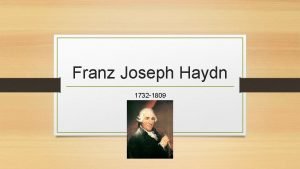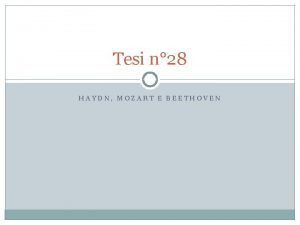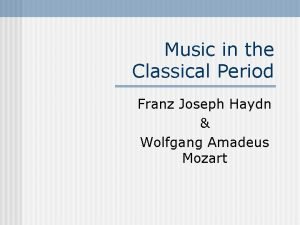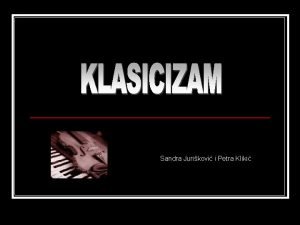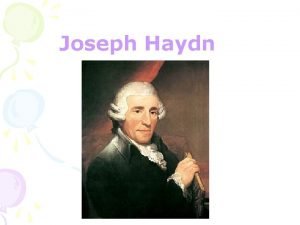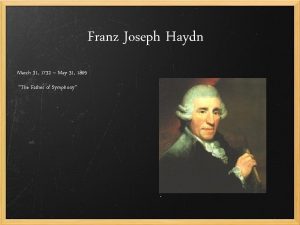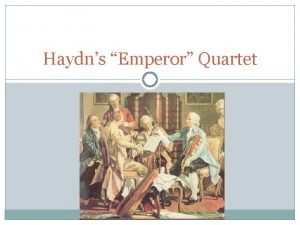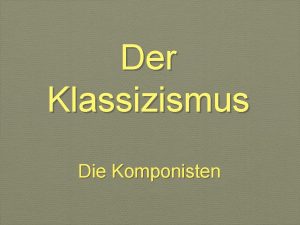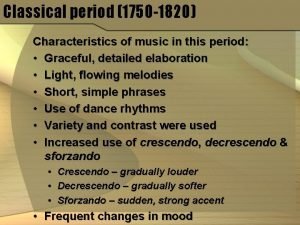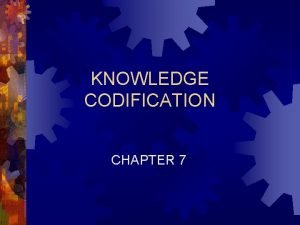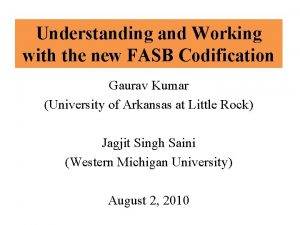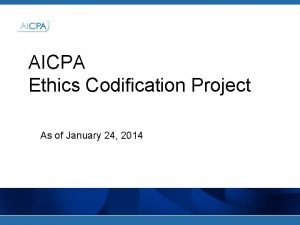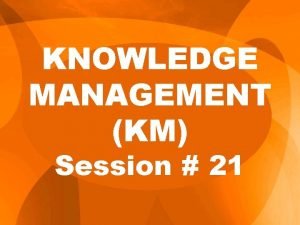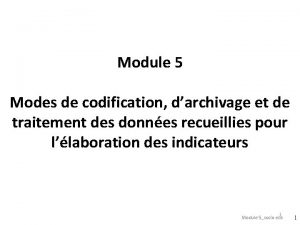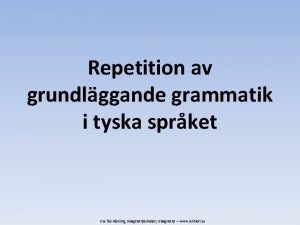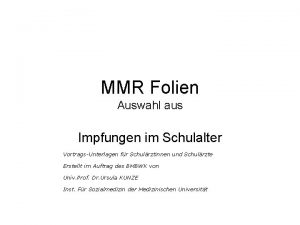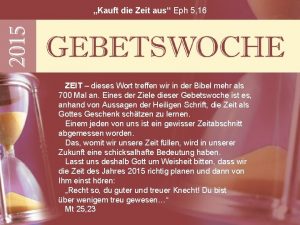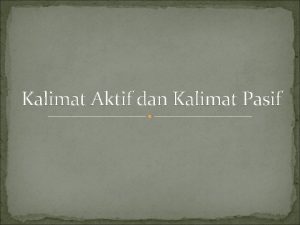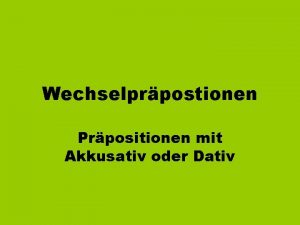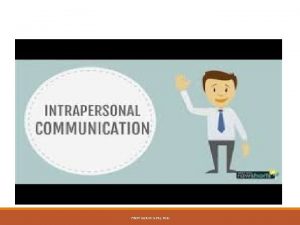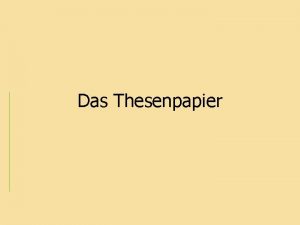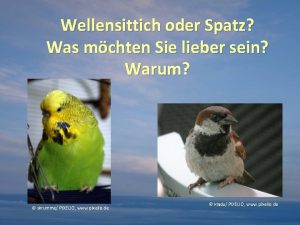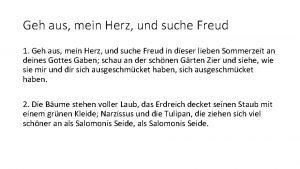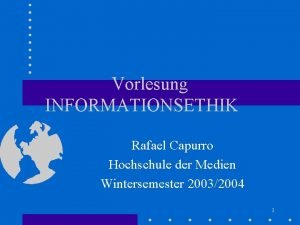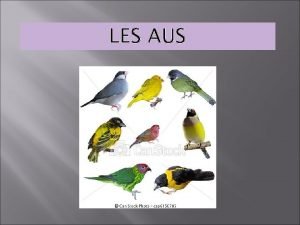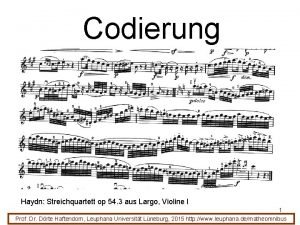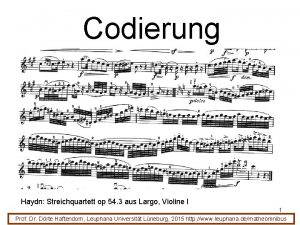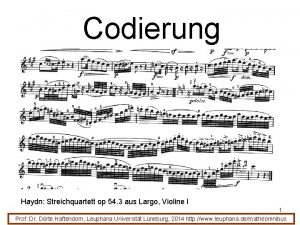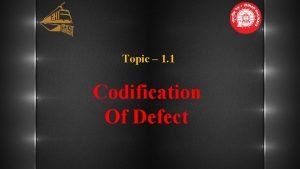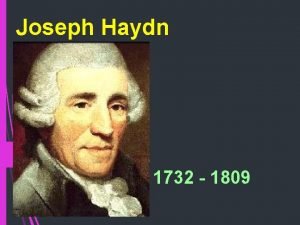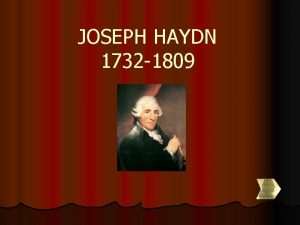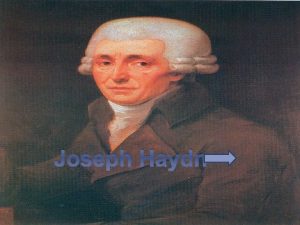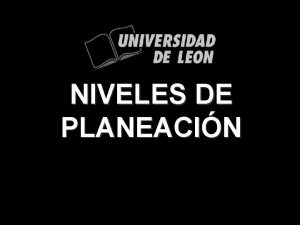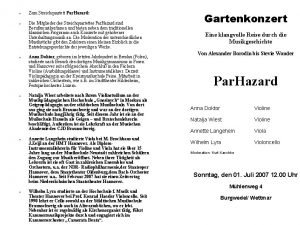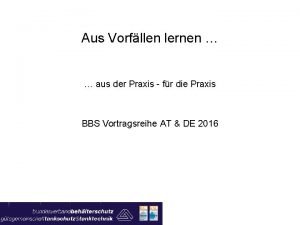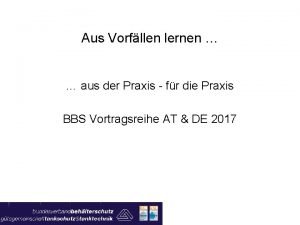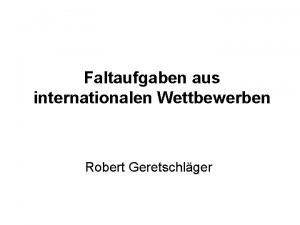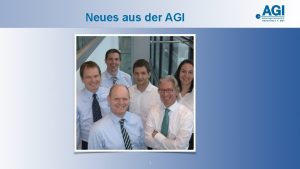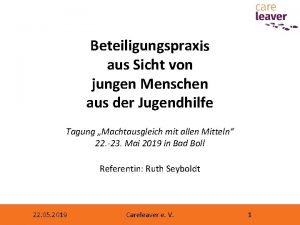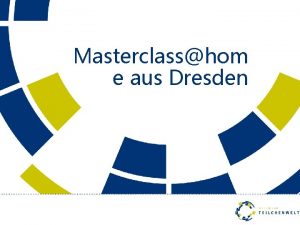Codification Haydn Streichquartett op 54 3 aus Largo
































- Slides: 32

Codification Haydn: Streichquartett op 54. 3 aus Largo, Violine I 1 Prof. Dr. Dörte Haftendorn, Leuphana Universität Lüneburg, 2013 http: //www. leuphana. de/matheomnibus

Codification 2 Prof. Dr. Dörte Haftendorn, Leuphana Universität Lüneburg, 2013 http: //www. leuphana. de/matheomnibus

EAN Europäische Artikelnummer Ziffern 1 und 2 codieren das Hersteller-Land. Ziffer 3 bis 12 codieren Händler und Ware. Die letzte Ziffer ist eine Prüfziffer. 3 Prof. Dr. Dörte Haftendorn, Leuphana Universität Lüneburg, 2013 http: //www. leuphana. de/matheomnibus

EAN European article number digits 1 and 2 encode the country of the producer digits 3 and 12 encode the merchant and article The last digit is a proof number. 4 Prof. Dr. Dörte Haftendorn, Leuphana Universität Lüneburg, 2013 http: //www. leuphana. de/matheomnibus

EAN Europäische Artikelnummer • This ist is made by pupils, 12 year old 5 Prof. Dr. Dörte Haftendorn, Leuphana Universität Lüneburg, 2013 http: //www. leuphana. de/matheomnibus

EAN European article number • The proof number has to be the complement to the next tenner. • proof number • ok 6 Prof. Dr. Dörte Haftendorn, Leuphana Universität Lüneburg, 2013 http: //www. leuphana. de/matheomnibus

EAN Switching of digits is often detected by the proof number 7 Prof. Dr. Dörte Haftendorn, Leuphana Universität Lüneburg, 2013 http: //www. leuphana. de/matheomnibus

EAN Switching of digits is often detected by the proof number • twisted • but noticed are the pairs: • Solution are • x-y=5 • x=y+5 8 Prof. Dr. Dörte Haftendorn, Leuphana Universität Lüneburg, 2013 http: //www. leuphana. de/matheomnibus

• In the last years one changed the type of the book number ISBN Switching of digits is always detected by the proof number. out of date • new: ISBN-13 9 Prof. Dr. Dörte Haftendorn, Leuphana Universität Lüneburg, 2013 http: //www. leuphana. de/matheomnibus

ISBN Zifferndreher werden immer von der Prüfziffer gemerkt. Der Grund: 11 ist Primzahl ist veraltet • neu: ISBN-13 • sie ist eine EAN • Die alte Buchnummer ohne Prüfziffer • 978 steht immer am Anfang der Buch-EAN 10 Prof. Dr. Dörte Haftendorn, Leuphana Universität Lüneburg, 2013 http: //www. leuphana. de/matheomnibus

ISBN Switching of digits is always detected by the proof number. The reason: 11 is a prime out of date • new: ISBN-13 • is a EAN • The old book number without proof number • 978 always in front • new EAN poof number 11 Prof. Dr. Dörte Haftendorn, Leuphana Universität Lüneburg, 2013 http: //www. leuphana. de/matheomnibus

ISBN out of date • new: ISBN-13 • is a EAN Switching of digits is always detected by the proof number. The reason: 11 is a prime • proof number must be: 4 12 Prof. Dr. Dörte Haftendorn, Leuphana Universität Lüneburg, 2013 http: //www. leuphana. de/matheomnibus

EAN 4003273103863 • 0001101 0100111101 0010011 …… • parity 1 • parity 0 • Using the parity the reading direction of the bar code is identifiable. The leading digit is encoded by the sequence in the first column. 4 -> ABA ABB 13 Prof. Dr. Dörte Haftendorn, Leuphana Universität Lüneburg, 2013 http: //www. leuphana. de/matheomnibus

EAN 4003273103863 The leading digit is encoded by the sequence in the first column. 4 -> ABA ABB parity= number of 1‘s mod 2 • parity 1 • parity 0 14 Prof. Dr. Dörte Haftendorn, Leuphana Universität Lüneburg, 2013 http: //www. leuphana. de/matheomnibus

Fehlerkorrigiende Codes • Wir betrachten binäre Codewörter aus 0 und 1 • Die Parität eines Codewortes ist • 0, wenn das Wort eine gerade Anzahl 1 hat • 1, wenn das Wort eine ungerade Anzahl 1 hat • Der Hammingabstand zweier Codewörter ist die Anzahl der unterschiedlich besetzten Stellen. 0101111 0111011 0101111 0000101 0010001 1010000 1000100 15 Prof. Dr. Dörte Haftendorn, Leuphana Universität Lüneburg, 2013 http: //www. leuphana. de/matheomnibus

Bug Corrective Codes • We look at binary code words made of 0 and 1 • The parity p of a code word is • 0, when the word has an even number of 1‘s • 1 when the word has an odd number of 1‘s • The Hamming distance h between two code words is the number of differently occupied positions. 0101111 0111011 0101111 0000101 0010001 1010000 1000100 16 Prof. Dr. Dörte Haftendorn, Leuphana Universität Lüneburg, 2013 http: //www. leuphana. de/matheomnibus

Fehler-erkennende Codes • Wir betrachten binäre Codewörter mit 3 Bit. 010 17 Prof. Dr. Dörte Haftendorn, Leuphana Universität Lüneburg, 2013 http: //www. leuphana. de/matheomnibus

Bug Corrective Codes • We look at binary code words with 3 bits. • Four words are allowed. • h=2 for all pairs of words 010 The code with this four words is able to recognize single-bit bugs. But they can‘t be corrected. 18 Prof. Dr. Dörte Haftendorn, Leuphana Universität Lüneburg, 2013 http: //www. leuphana. de/matheomnibus

Fehlerkorrigiende Codes • Code mit Hammingabstand mindestens 3 Erlaubte • IIIOIIOI IOOIIIOO IOOIOOII Codewörter • Nun tritt einziger Fehler auf. • IOOIOIOO • Den Fehler entdeckt man dadurch, dass es kein zulässiges Wort ist. • Die letzte Ziffer ist oft die Parität des davor stehenden Wortes. Dann sieht man den Fehler an der falschen Parität. • Das falsche Wort hat vom mittleren Codewort den Hammingabstand 1. Von den anderen Codewörtern hat es den Hammingabstand mind. 2. • Man nimmt dieses „nahe“ Codewort anstelle des falschen. • IOOIIIOO wird jetzt nach dem Fehler genommen • Nun ist alles wieder richtig. 19 Prof. Dr. Dörte Haftendorn, Leuphana Universität Lüneburg, 2013 http: //www. leuphana. de/matheomnibus

Bug Corrective Codes • Code with Hamming distance at least 3 allowed • IIIOIIOI IOOIIIOO IOOIOOII code words • Now a single-bit bug occurs • IOOIOIOO • The bug is discoverd, because this is not an allowed word. . • Often the last digit is the parity of the Word in front. Then you find the bug, because the parity is false. • The false word has Hamming distance 1 from the word in the middle (above ). The Hammning distance to the other code words is at least 2. • One takes this „nearest“ code word instead of the false word. • IOOIIIOO is now taken for futher usage. Now every thing is correct again. 20 Prof. Dr. Dörte Haftendorn, Leuphana Universität Lüneburg, 2013 http: //www. leuphana. de/matheomnibus

Hamming-Code • Richard Hammming fand 1948 als Erster einen fehlerkorrigierenden Code. • Wir betrachten einen Code aus 4 Bits. • Alle 2^4=16 möglichen Wörter sind erlaubt. • Die Nachricht: IOII Gesendet wird: 21 Prof. Dr. Dörte Haftendorn, Leuphana Universität Lüneburg, 2013 http: //www. leuphana. de/matheomnibus

Hamming Code • Richard Hammming was in 19948 the first to invent a bug corrective code. • We look at a code with 4 bits. • All 2^4=16 possible words are allowed. • The message: IOII will be transmitted 22 Prof. Dr. Dörte Haftendorn, Leuphana Universität Lüneburg, 2013 http: //www. leuphana. de/matheomnibus

Hamming-Code • Zu je vier eigentlich zu sendenden Bits der Nachricht werden drei „Prüfbits" berechnet und angehängt. Das Kreisbild verdeutlicht das Vorgehen: • Schreibe die Nachricht in die blauen Felder 1, 2, 3, 4. • Schreibe in die grünen Felder die Parität der im zugehörigen Kreis stehenden Bits. • Hänge die Bits der Felder 5, 6, 7 an die Nachricht an. • Der Empfänger trägt die sieben Bits in die Felder ein und prüft, ob alles richtig ist. • Nachricht. IOII • Gesendetes Wort IOIIOIO 23 Prof. Dr. Dörte Haftendorn, Leuphana Universität Lüneburg, 2013 http: //www. leuphana. de/matheomnibus

Hamming Code • The message, which we will send, is splitted in packages of four bits. We calculate tree proof bits for every four message bits and attach them to the four bits. The following picture with the circles explains the method: • The regions are numbered as shown. Write the four message bits in the blue inner regions 1, 2, 3, 4 • Write in the green regions 5, 6, 7 the parity of the bits in the correspondent circles. • Attach the bits in regions 5, 6, 7 to the four message bits. • The receiver puts all seven bits in the three circles and checks if all is correct. • message. IOII • transmitted word IOIIOIO 24 Prof. Dr. Dörte Haftendorn, Leuphana Universität Lüneburg, 2013 http: //www. leuphana. de/matheomnibus

Funktioniert der Hamming-Code ? • Nachricht. IOII • Gesendetes Wort IOIIOIO Sendekanal Wir betrachten nur den Fall: genau ein Fehler. • Empfangenes Wort OOIIOIO mit Fehler 25 Prof. Dr. Dörte Haftendorn, Leuphana Universität Lüneburg, 2013 http: //www. leuphana. de/matheomnibus

Does the Hamming Code Work? • message. IOII • sent word IOIIOIO transmission channel We only look at the case: only one single-bit bug. • received word OOIIOIO with bug • receiver detect: 5 and 6 are false. • He changes the bit at the position 1. • He takes: • all right IOIIOIO 26 Prof. Dr. Dörte Haftendorn, Leuphana Universität Lüneburg, 2013 http: //www. leuphana. de/matheomnibus

Funktioniert der Hamming-Code ? • Gesendetes Wort IOIIOIO • Empfangenes Wort • Fehler Platz 4 IOIOOIO • Fehler Platz 5 IOI I I IO Aufgabe: Sie empfangen: OIOIOOI. Was ist das richtige Wort? 27 Prof. Dr. Dörte Haftendorn, Leuphana Universität Lüneburg, 2013 http: //www. leuphana. de/matheomnibus

Does the Hamming Code Work? • sent word IOIIOIO • received word • bug at position 4 IOIOOIO • bug at position 5 IOI I I IO Problem: You receive: OIOIOOI. What is the correct word? 28 Prof. Dr. Dörte Haftendorn, Leuphana Universität Lüneburg, 2013 http: //www. leuphana. de/matheomnibus

Funktioniert der Hamming-Code ? Aufgabe: Sie empfangen: OIOIOOI. Was ist das richtige Wort? • Gesendetes Wort ? ? ? ? OIOIOOI 29 Prof. Dr. Dörte Haftendorn, Leuphana Universität Lüneburg, 2013 http: //www. leuphana. de/matheomnibus

Does the Hamming Code Work? sent word ? ? ? ? OIOIOOI Yes, yet the old Hamming code can correct single-bit bugs automatically. Today one has improved bug corrective codes. 30 Prof. Dr. Dörte Haftendorn, Leuphana Universität Lüneburg, 2013 http: //www. leuphana. de/matheomnibus

Bug Corrective Codes or Why Does the CD not Crackle? 31 Prof. Dr. Dörte Haftendorn, Leuphana Universität Lüneburg, 2013 http: //www. leuphana. de/matheomnibus

Fehlerkorrigierende Codes oder warum CD nicht knackt 32 Prof. Dr. Dörte Haftendorn, Leuphana Universität Lüneburg, 2013 http: //www. leuphana. de/matheomnibus
 1809-1732
1809-1732 Franz joseph haydn mappa concettuale
Franz joseph haydn mappa concettuale Characteristics of franz joseph haydn
Characteristics of franz joseph haydn Joseph haydn zanimljivosti
Joseph haydn zanimljivosti Joseph haydn prezentace
Joseph haydn prezentace Franz kafka lub joseph haydn
Franz kafka lub joseph haydn Haydn kaiser quartet
Haydn kaiser quartet Joseph haydn bekannteste werke
Joseph haydn bekannteste werke Franz joseph haydn characteristics of music
Franz joseph haydn characteristics of music Codification of knowledge
Codification of knowledge Fasb codification system
Fasb codification system Aicpa ethics codification
Aicpa ethics codification Codification of international law
Codification of international law Codification sequentielle
Codification sequentielle Codification vs personalization
Codification vs personalization Tableau de dépouillement questionnaire
Tableau de dépouillement questionnaire Gegenteil von wurzel
Gegenteil von wurzel Nominativ tyska
Nominativ tyska Wie sehen impfröteln aus
Wie sehen impfröteln aus Kauft die zeit aus
Kauft die zeit aus Syarat kalimat aktif
Syarat kalimat aktif Boiler tropft aus gehäuse
Boiler tropft aus gehäuse über akkusativ oder dativ
über akkusativ oder dativ Contoh teori aus
Contoh teori aus Niklaus
Niklaus Fr brise
Fr brise Wie sieht ein thesenpapier aus
Wie sieht ein thesenpapier aus Als mein gelber wellensittich aus dem fenster flog
Als mein gelber wellensittich aus dem fenster flog Die glucke führt ihr völklein aus
Die glucke führt ihr völklein aus Ziele der personalentwicklung aus unternehmenssicht
Ziele der personalentwicklung aus unternehmenssicht Drei dinge sind uns aus dem paradies geblieben
Drei dinge sind uns aus dem paradies geblieben Utilitarismus
Utilitarismus Caracteristiques de les aus
Caracteristiques de les aus
